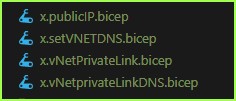Observations on ARM (Bicep) Templates
- Azure Deployment Framework
- Go Home Documentation Home
- Go Next Tools Setup
Naming Standards Bicep - These are a work in progress.
Azure Resource Group Deployment - Multi-Region/Multi-Tier Hub/Spoke Environments
Common naming standards/conventions/examples for Bicep:
Bicep is new, so this is a work in progress and subject to change.
- Currently ALL Bicep files are in the same directory e.g. bicep
- Files that begin with ‘sub’ E.g. sub-XYX.bicep should be deployed into the Subscription Scope.
- There are some Parent Deployments, one for Subscription Scope and one for the Resource Group Scope.
- 00-ALL-SUB.bicep
- 01-dp-rg-ALL.bicep
- The above files will orchestrate full deployments, since they only call child Bicep Modules. These are what you call in your pipelines.
- Each resource type has a main file to deploy that resource and associated capabilities e.g. storage is SA.bicep
- That main bicep file will use bicep Modules to deploy components that are related and also to loop through arrays of those items E.g. storage accounts
- These related modules will start with the same name, then have a dash E.g. SA-Storage.bicep
- So you would never call that file directly, you would only call SA.bicep in a deployment for storage accounts.
- The above nesting can be multiple levels e.g. sub-RBAC.bicep –> sub-RBAC-ALL.bicep –> sub-RBAC-ALL-RA.bicep
-
Again you would only ever want to deploy sub-RBAC.bicep, not the children.

-
- Use a dot notation for segmenting Resource types into more descriptive categories
- An example is: SA.bicep for storage OR SA.CDN.bicep for a CDN
- The dot allows for more specific names to describe the bicep file, however diferentiates the dash used for nested deployments.
- In the ARM (Bicep) Templates, numbers are used on the templates, however no numbering has been implemented here so far, except on the parent deployments mentioned above.
- Any deployment names to Bicep modules will begin with ‘dp’, these are used for the deployment names e.g. in the Portal.
- Currently some parameter names that have been migrated from ARM templates will maintain the casing, which is not camel case
- Where it makes sense camel case will be used for param/variable/resource names, where it doesn’t break backwards compatiblity
-
Helper functions are currently prefixed with an x.file.bicep, these are reusable bicep modules that can be called from more than 1 parent module.
